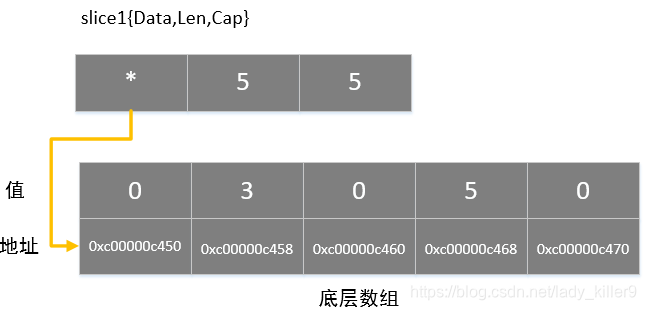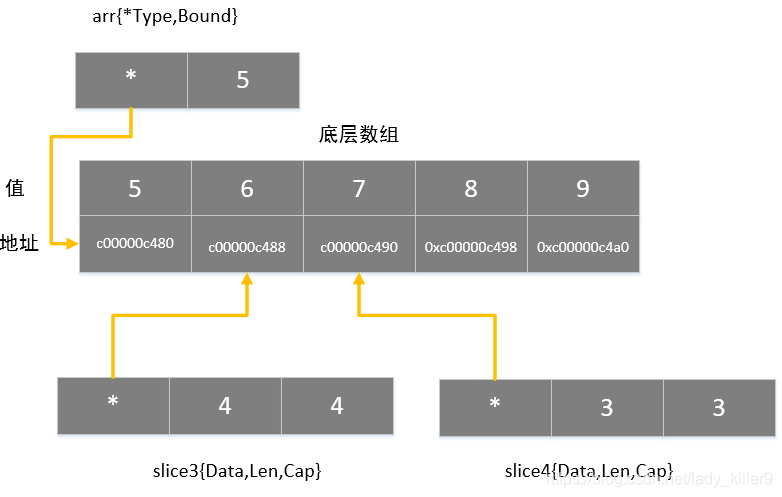

网上学习资料一大堆,但如果学到的知识不成体系,遇到问题时只是浅尝辄止,不再深入研究,那么很难做到真正的技术提升。
一个人可以走的很快,但一群人才能走的更远!不论你是正从事IT行业的老鸟或是对IT行业感兴趣的新人,都欢迎加入我们的的圈子(技术交流、学习资源、职场吐槽、大厂内推、面试辅导),让我们一起学习成长!
目录
上篇文章思考题
答案:
can not use nums(type [6]int) as type[5]int
注意:一个数组类型,包含元素类型和长度,不同长度,同样的元素也是不一样的类型。因此,今天的切片就很有意义。
简介
- 切片是引用类型
- 长度可以变化,容量随长度变化
- 是结构体–>可查看源代码
切片即动态数组,底层在当前数组不够用时,开辟更大的数组,拷贝后再增加元素。
声明
var 变量名 []type
func make(Type, size …IntegerType[,capacity]) Type
内建函数make分配并初始化一个类型为切片、映射、或通道的对象。其第一个实参为类型,而非值。make的返回类型与其参数相同,而非指向它的指针。其具体结果取决于具体的类型:
切片:size指定了其长度。该切片的容量等于其长度。切片支持第二个整数实参可用来指定不同的容量;它必须不小于其长度,因此 make([]int, 0, 10) 会分配一个长度为0,容量为10的切片。
capacity可选,默认为指定的长度,make底层也有数组,不可见

源代码查看
src->runtime->slice.go
func makeslice(et \*\_type, len, cap int) unsafe.Pointer {
mem, overflow := math.MulUintptr(et.size, uintptr(cap))
if overflow || mem > maxAlloc || len < 0 || len > cap {
// NOTE: Produce a 'len out of range' error instead of a
// 'cap out of range' error when someone does make([]T, bignumber).
// 'cap out of range' is true too, but since the cap is only being
// supplied implicitly, saying len is clearer.
// See golang.org/issue/4085.
mem, overflow := math.MulUintptr(et.size, uintptr(len))
if overflow || mem > maxAlloc || len < 0 {
panicmakeslicelen()
}
panicmakeslicecap()
}
return mallocgc(mem, et, true)
}

切片声明代码
var slice []int
slice1 := make([]int,5)
fmt.Println("slice slice1:",slice,slice1)

声明并初始化
一般形式
类似数组,直接写后面花括号里面,代码:
slice2 := []int{1,2,3,4}

引用数组
给出数组数据
arr := [5]int{5,6,7,8,9}

slice[start:end],默认:start=0,end =len(arr)
代码
slice3 := arr[1:]
引用切片
和引用数组类似
slice4 := slice3[1:]
切片及数组在内存的情况,请查看后序内存一节。
遍历
for
for i:=0;i<len(slice3);i++{
fmt.Print(slice3[i]," ")
}
for range
for _,v := range slice3{
fmt.Print(v," ")
}
内存
查看结构体的具体内容
src->reflect->type.go
type SliceHeader struct {
Data uintptr
Len int
Cap int
}

编译时创建切片代码
src->cmd->compile->types
// NewSlice returns the slice Type with element type elem.
func NewSlice(elem \*Type) \*Type {
if t := elem.Cache.slice; t != nil {
if t.Elem() != elem {
Fatalf("elem mismatch")
}
return t
}
t := New(TSLICE)
t.Extra = Slice{Elem: elem}
elem.Cache.slice = t
return t
}

fmt.Printf("&slice1:%p,&slice1[0]:%v\n", &slice1, &slice1[0])
fmt.Printf("&arr:%p &arr[1]:%v &slice3:%p &slice3[0]:%v\n",&arr,&arr[1],&slice3,&slice3[0])
fmt.Printf("&slice4:%p &slice4[0]:%v\n",&slice4,&slice4[0])
arr[2] = 99
fmt.Println("slice3[1] slice4[0]",slice3[1],slice4[0])

slice1内存

arr、slice3、slice4内存
函数/方法
长度与容量
len、cap函数获取长度和容量
代码
fmt.Println("len(slice3) cap(slice3) len(slice4) cap(slice4):", len(slice3), cap(slice3), len(slice4), cap(slice4))
追加与拷贝
append
func append(slice []Type, elems …Type) []Type
内建函数append将元素追加到切片的末尾。若它有足够的容量,其目标就会重新切片以容纳新的元素。否则,就会分配一个新的基本数组。append返回更新后的切片,因此必须存储追加后的结果。
查看slice增长源代码
src->runtime->slice.go
// growslice handles slice growth during append.
// It is passed the slice element type, the old slice, and the desired new minimum capacity,
// and it returns a new slice with at least that capacity, with the old data
// copied into it.
// The new slice's length is set to the old slice's length,
// NOT to the new requested capacity.
// This is for codegen convenience. The old slice's length is used immediately
// to calculate where to write new values during an append.
// TODO: When the old backend is gone, reconsider this decision.
// The SSA backend might prefer the new length or to return only ptr/cap and save stack space.
func growslice(et \*\_type, old slice, cap int) slice {
if raceenabled {
callerpc := getcallerpc()
racereadrangepc(old.array, uintptr(old.len*int(et.size)), callerpc, funcPC(growslice))
}
if msanenabled {
msanread(old.array, uintptr(old.len*int(et.size)))
}
if cap < old.cap {
panic(errorString("growslice: cap out of range"))
}
if et.size == 0 {
// append should not create a slice with nil pointer but non-zero len.
// We assume that append doesn't need to preserve old.array in this case.
return slice{unsafe.Pointer(&zerobase), old.len, cap}
}
newcap := old.cap
doublecap := newcap + newcap
if cap > doublecap {
newcap = cap
} else {
if old.cap < 1024 {
newcap = doublecap
} else {
// Check 0 < newcap to detect overflow
// and prevent an infinite loop.
for 0 < newcap && newcap < cap {
newcap += newcap / 4
}
// Set newcap to the requested cap when
// the newcap calculation overflowed.
if newcap <= 0 {
newcap = cap
}
}
}
var overflow bool
var lenmem, newlenmem, capmem uintptr
// Specialize for common values of et.size.
// For 1 we don't need any division/multiplication.
// For sys.PtrSize, compiler will optimize division/multiplication into a shift by a constant.
// For powers of 2, use a variable shift.
switch {
case et.size == 1:
lenmem = uintptr(old.len)
newlenmem = uintptr(cap)
capmem = roundupsize(uintptr(newcap))
overflow = uintptr(newcap) > maxAlloc
newcap = int(capmem)
case et.size == sys.PtrSize:
lenmem = uintptr(old.len) * sys.PtrSize
newlenmem = uintptr(cap) * sys.PtrSize
capmem = roundupsize(uintptr(newcap) * sys.PtrSize)
overflow = uintptr(newcap) > maxAlloc/sys.PtrSize
newcap = int(capmem / sys.PtrSize)
case isPowerOfTwo(et.size):
var shift uintptr
if sys.PtrSize == 8 {
// Mask shift for better code generation.
shift = uintptr(sys.Ctz64(uint64(et.size))) & 63
} else {
shift = uintptr(sys.Ctz32(uint32(et.size))) & 31
}
lenmem = uintptr(old.len) << shift
newlenmem = uintptr(cap) << shift
capmem = roundupsize(uintptr(newcap) << shift)
overflow = uintptr(newcap) > (maxAlloc >> shift)
newcap = int(capmem >> shift)
default:
lenmem = uintptr(old.len) * et.size
newlenmem = uintptr(cap) * et.size
capmem, overflow = math.MulUintptr(et.size, uintptr(newcap))
capmem = roundupsize(capmem)
newcap = int(capmem / et.size)
}
// The check of overflow in addition to capmem > maxAlloc is needed
// to prevent an overflow which can be used to trigger a segfault
// on 32bit architectures with this example program:
//
// type T [1<<27 + 1]int64
//
// var d T
// var s []T
//
// func main() {
// s = append(s, d, d, d, d)



**既有适合小白学习的零基础资料,也有适合3年以上经验的小伙伴深入学习提升的进阶课程,涵盖了95%以上Go语言开发知识点,真正体系化!**
**由于文件比较多,这里只是将部分目录截图出来,全套包含大厂面经、学习笔记、源码讲义、实战项目、大纲路线、讲解视频,并且后续会持续更新**
**[如果你需要这些资料,可以戳这里获取](https://bbs.csdn.net/topics/618658159)**
n 32bit architectures with this example program:
//
// type T [1<<27 + 1]int64
//
// var d T
// var s []T
//
// func main() {
// s = append(s, d, d, d, d)
[外链图片转存中...(img-KfC223bW-1715805295765)]
[外链图片转存中...(img-rlJFcT1K-1715805295765)]
[外链图片转存中...(img-16XpCo9g-1715805295766)]
**既有适合小白学习的零基础资料,也有适合3年以上经验的小伙伴深入学习提升的进阶课程,涵盖了95%以上Go语言开发知识点,真正体系化!**
**由于文件比较多,这里只是将部分目录截图出来,全套包含大厂面经、学习笔记、源码讲义、实战项目、大纲路线、讲解视频,并且后续会持续更新**
**[如果你需要这些资料,可以戳这里获取](https://bbs.csdn.net/topics/618658159)**























 1792
1792

 被折叠的 条评论
为什么被折叠?
被折叠的 条评论
为什么被折叠?








